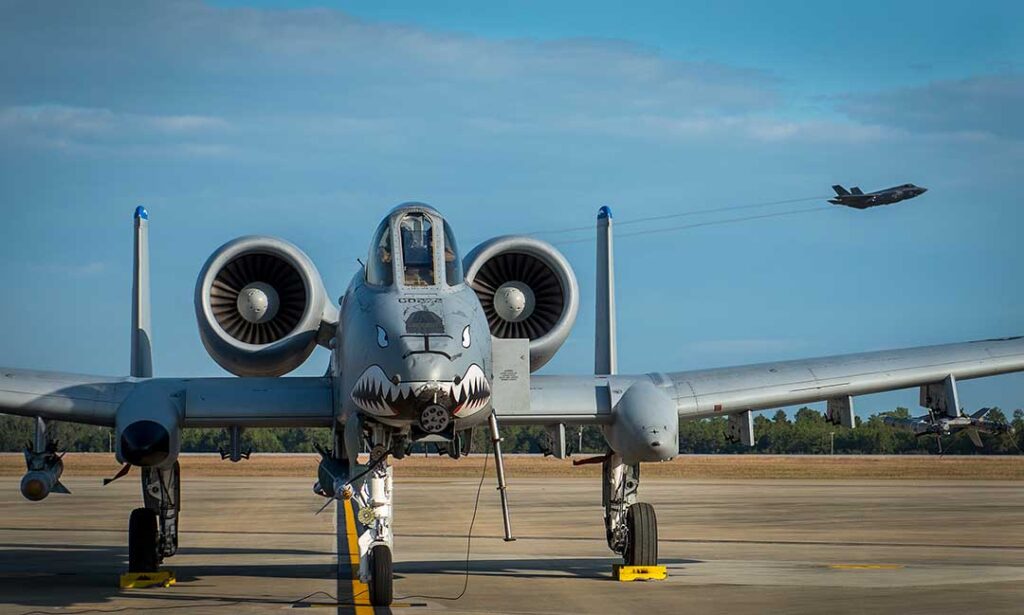THE WATCH STAFF
U.S. Air Force Secretary Frank Kendall said the United States must urgently focus on developing new warplanes to keep pace with the military modernization undertaken by the People’s Republic of China (PRC).
The first step toward countering the PRC’s rapid advancements is to retire the Air Force’s outdated aircraft such as the MQ-9 Reaper drone, some C-130s, older tankers and the A-10 Warthog, Kendall said December 4, 2021, at the Reagan National Defense Forum, according to Defense News.
“If it doesn’t threaten China, why are we doing it?” Kendall asked during a panel discussion at the annual event at the Ronald Reagan Presidential Library in Simi Valley, California.
(Pictured: An A-10 Thunderbolt II sits on the flight line at Eglin Air Force Base in Florida as an F-35A Lightning II streaks by in the background.)
Kendall said the Air Force has often attempted to mothball “old iron,” only to encounter resistance from lawmakers seeking to protect jobs in their states, according to Defense News.
Kendall’s views were echoed by Air Force Chief of Staff Gen. Charles Q. Brown.
“It’s really a tough decision … how we transition from the current capabilities we have, to get to the capabilities of the future,” Brown told Defense News of the Pentagon’s budget proposal that goes to Congress in early 2023.
Brown pointed out that for the past two decades, the Air Force has operated largely in the Middle East, where adversaries lack advanced anti-aircraft systems. He said the Air Force will need to strike a balance as it modernizes to ensure there’s enough inventory for the military’s combatant commanders to carry out their missions.
Brown said he’s asked them to support the aircraft retirements in the face of difficult short-term tradeoffs.
“One of the things I’ve found is the United States Air Force is very popular,” Brown told Defense News, “and as I talk to combatant commanders, they tend to ask for more Air Force.”
Kendall told Politico that the Air Force will seek funding to develop programs for classified drones that are designed to operate alongside warplanes.
“I’ve got two that I’m going to have in the ’23 budget in some form,” Kendall told Politico December 6. “They’re both unmanned air-combat vehicles … designed to work in conjunction with fighter aircraft like [the Next Generation Air Dominance fighter] or F-22 or the F-35,” he said. “On the other hand, they work in conjunction with bombers like the B-21.”
Kendall said preliminary work for both drone programs is underway.
The proposals take on added significance, considering Kendall’s call for Air Force warplane modernization, according to Politico.
“The [classified drone] disclosure is the strongest indication yet that the service is banking on autonomous weapon systems to give it an edge in the increasingly fierce military competition with China,” Politico said.
The U.S., in addition to Australia, Britain, India and Russia, are among the nations developing “loyal wingman” drones to help protect pricier crewed fighter jets, according to a September 29 Reuters story.
The PRC unveiled a drone concept September 29, which is similar to the Valkyrie unmanned aerial vehicle (UAV) tested by the U.S. Air Force in 2021, according to Reuters.
“The number of players has expanded dramatically in the unmanned aerial vehicle space,” retired Air Force Lt. Gen. Dave Deptula, the former deputy chief of staff for intelligence, surveillance and reconnaissance who now runs the Mitchell Institute for Aerospace Studies, told Politico.
“The UAV industry is one that is expanding, not contracting.”
IMAGE CREDIT: SAMUEL KING JR./U.S. AIR FORCE

